20 Dec Hoping for the best for our world in 2018
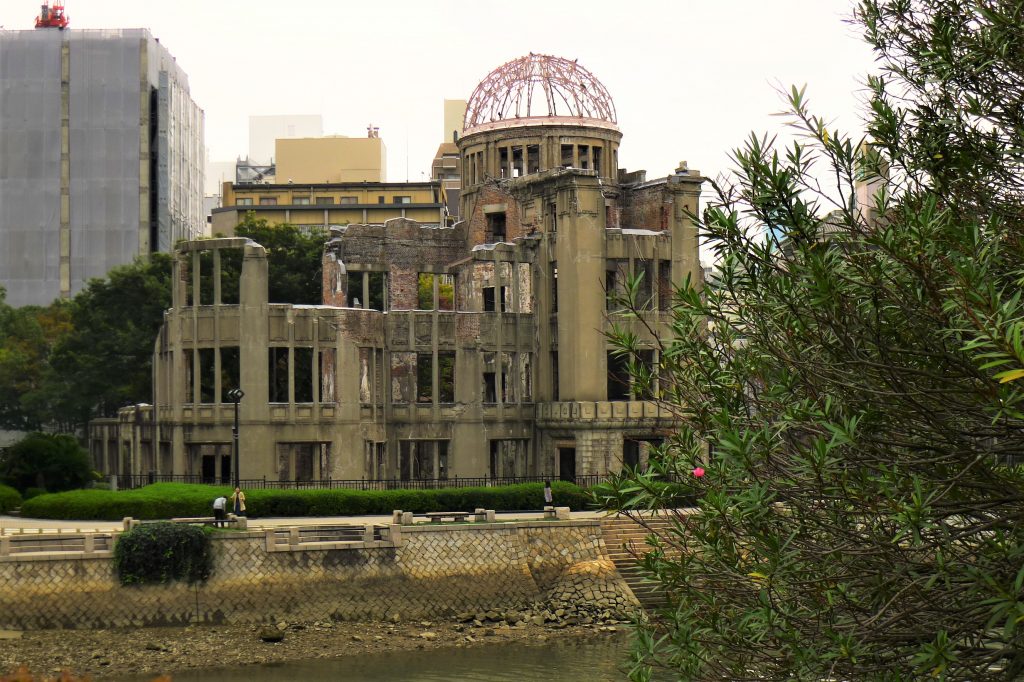
The skeletal dome that marks ground zero for the atomic bomb that deciated Hiroshima is now part of the city’s Peace Memorial Park.
We live in tumultuous – and possibly perilous – times. Our government and society at large is more divided than I can remember, even during my childhood in the 1960s. Race and gender issues fill the headlines every day, and that’s just looking at domestic headlines. It’s not “fake news” to say that our country is struggling today, on a variety of levels on a variety of topics.
The United States’ international standing is diminished too, because our government has made some moves that have been very unpopular worldwide, such as officially naming Jerusalem as the capital of Israel and planning to move our embassy there, and blocking travel (and immigration) from a handful of Muslim-majority countries. The US has also turned its back on a handful of treaties and positions we’ve led for decades, including pulling out of the Climate Accords, renegotiating NAFTA, the Iranian nuclear agreement, and dropping out of the Trans-Pacific Partnership (TPP), which would have made us a part of a multi-country Asian trade pact. Now, those Asian countries are creating their own open trading deals, and China has established itself as the most powerful economic force in the region.
Most alarmingly, there’s a new nuclear threat in the world: North Korea.
North Korea’s unpredictable, immature ruler, Kim Jong-un claims to have the ability to fire nuclear armed missiles that can strike the Unites States – not just US territories like Guam, but the mainland states. We’ll see if his claims are true, but the fact is that Americans are living under the threat of mushroom-cloud destruction for the first time in a generation, since the Cold War ended in the 1980s.
President Trump has used inflammatory language that pushed Kim into conducting a series of missile tests and underground nuclear tests. Some of the test missiles fell into the sea between Korea and Japan, and a couple of ballistic missiles flew over Japan into the Pacific. One flew over southern Hokkaido, Japan’s northernmost island, and I thought about my mom’s hometown, Nemuro, which is located at the southeastern-most tip of Hokkaido.
Even if a nuclear war doesn’t break out with North Korea, a conventional war of ground troops and short-range missiles would be devastating to the entire region. Japan is within easy reach and Seoul, South Korea’s capital, is a mere 35 miles from the border with the North, and only 120 miles from Pyongyang, the North’s capital. Many thousands of Americans – both military and their families, and civilians – live and work in Seoul and throughout South Korea. Ditto the presence of many Americans, from military and businesspeople to students and tourists, in Japan.
Japan is now buying missiles that can strike North Korea if it’s attacked. The US and its allies have stepped up military drills in the region.
With our president and North Korea’s “Dear Leader” waging a war of words, tensions are high that fighting could become a reality. An United Nations envoy who visited North Korea says “time if of the essence” to calm down the rhetoric and potential for war. Even China, Kim’s staunchest ally and economic lifeline, is now preparing refugee camps within its border for North Koreans who may be fleeing the possible coming conflagration.
The possibility of nuclear war is a clear and present danger in the world, in a way that is much more vivid than in decades. Like Americans were taught to “duck and cover” and families built nuclear fallout shelters during the Cold War era, Japanese citizens today are living through drills on what to do if a nuclear attack is imminent. What? This is like a nightmare scene from a “Terminator” movie.
The Japanese are very aware – the most aware of anyone in the world – of the horrors of nuclear war. It remains the only country ever to suffer the effects of nuclear bombs. The Atomic Bomb helped end World War II but at a terrible cost, vaporizing much of two cities, Hiroshima and Nagasaki, in August of 1945.
And though the Japanese may be living in fear now, I’m hopeful that the worst will not happen.
There are reports that North Korea may be negotiating via Russian back channels to avoid this disaster, which is certainly gives me hope. Kim may be crazy, and many North Koreans may be resigned to die in war. But I don’t think Kim himself has a death wish. I think he understands the terrible power of the arms he’s been building, and I hope he ultimately will use them as bargaining chips with the rest of the world, instead of triggering a planetary conflagration.
I wish he’d visit Hiroshima and learn first-hand the destruction nuclear weapons can wreak.
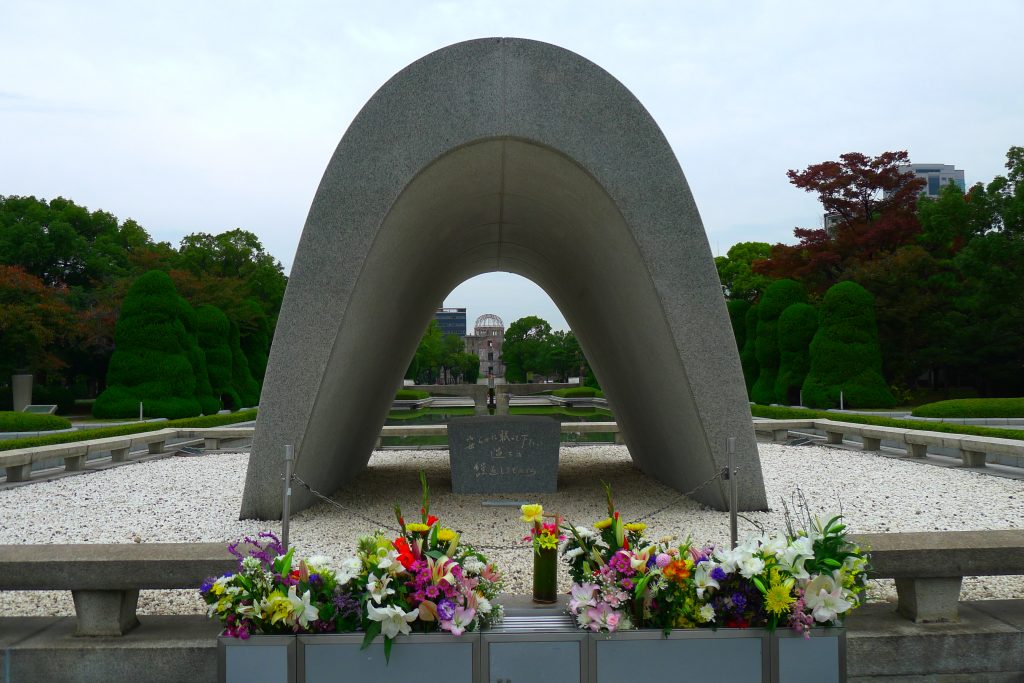
This Cenotaph memorializes the names of every victim of the atomic bomb that destroyed Hiroshima, and gives visitors who pay tribute a straight view past an eternal flame to the atomic bomb dome.
I visited Hiroshima’s Peace Memorial Park as a child, when my family lived in Japan. And as an adult, I’ve visited the park and its powerful museum with my mom and with my wife and in-laws.
It’s a solemn, yet hopeful place. The arch of the cenotaph monument that covers the name of every victims of the bomb that exploded over Hiroshima is set so as a visitor pays respect to the dead, the view through the arch centers on the dramatic skeletal dome of the one building that remains from that day, which was left as a memorial at ground zero.
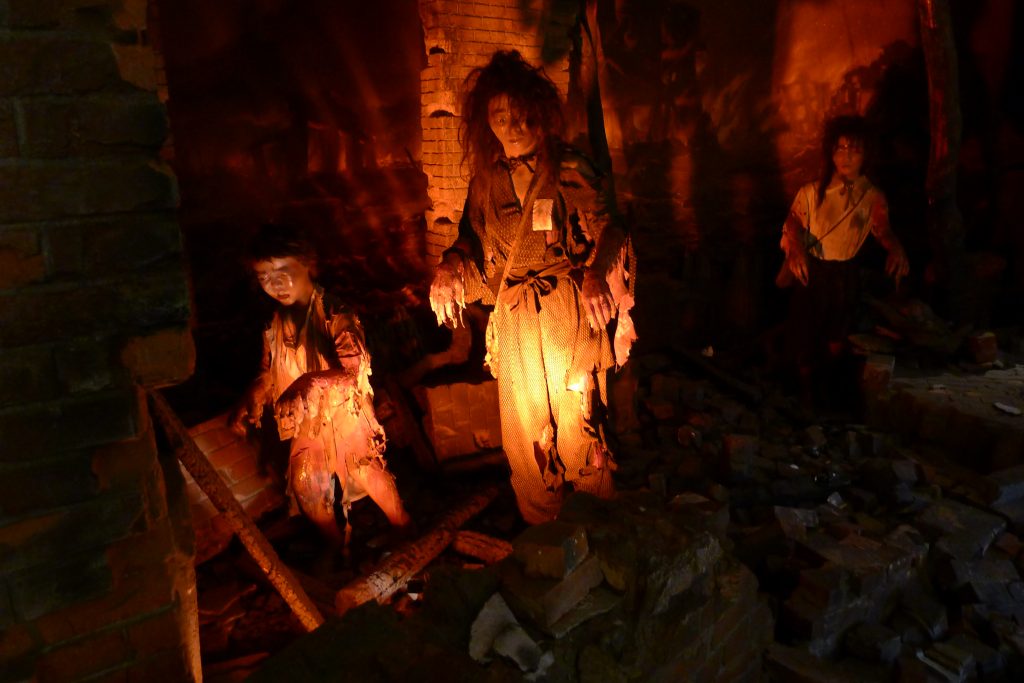
One of the grisly dioramas at the Hiroshima Peace Memorial Park Museum, recreating what happened to civilians when the atomic bomb was dropped.
The museum shows in stark displays of photos, artifacts and recreations of the fiery destruction what the civilian citizens (and many Americans including POWs, by the way) suffered. Odd pieces of humanity survived – a bento box, a tricycle, scraps of clothing with the bodies they covered long gone.
When my wife and I took my mom to Hiroshima and walked through this somber, emotional museum, we asked what she thought. She had never spoken much about her wartime experience growing up in Nemuro, a small fishing city in Hokkaido, Japan’s northernmost island. But with some prodding, she opened up about the firebombing that Nemuro suffered just months before the end of the war. It wasn’t an atomic bomb, so she didn’t see nuclear holocaust. But she saw a neighbor who was running toward her family with houses in flames all around them. “He just blew up,” she said, with a faraway look in her eyes.
Hiroshima and Nagasaki are reminders to everyone in Japan about the ultimate horrors of war — the type of horror that now looms over the Earth again, 70 years later.
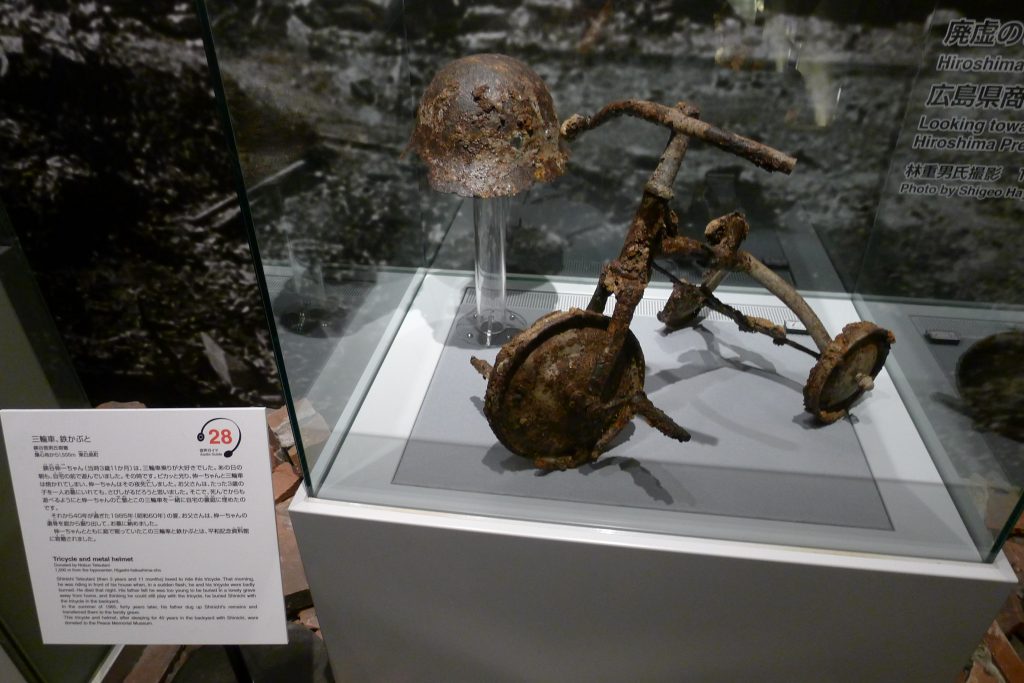
One of the objects on display, a tricycle that was left in the wake of the nuclear blast.
The grounds of the Hiroshima Memorial Peace Park also hosts a statue of Sadako Sasaki, a girl who lived a little over a mile from ground zero when the A-bomb exploded when she was two years old.
She survived the bombing, but died when she was 12, of radiation-linked Leukemia. As she fell ill, she made origami cranes, trying to fold 1,000 cranes, which in Japanese folklore means long life. Her story was memorialized in the book “Sadako and the Thousand Paper Cranes.” Children throughout the world now make strings of 1,000 cranes and send them to the Peace Park, where they’re stored in display cases surrounding a bell and statue of Sadako.
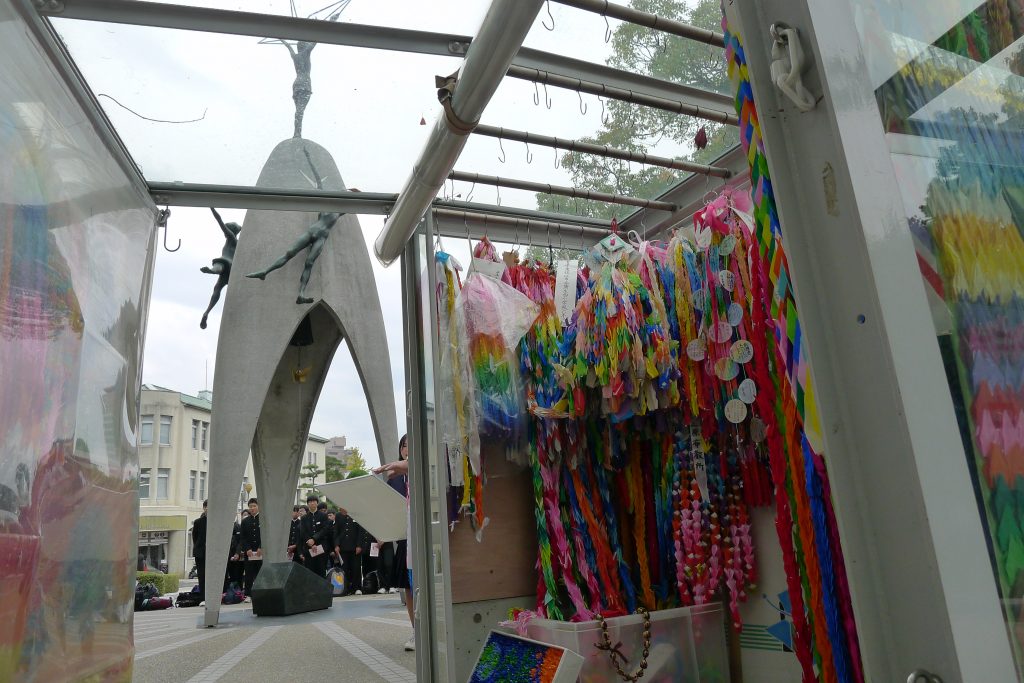
Today, students all over the world make strings of origami cranes and send them to the Hiroshima Memorial Peace Park, where they’re added to display cases that surround Sadako’s statue whose statue is frozen in a gracefull dance atop the memorial.
Sadako’s spirit of hope helps me be hopeful for the future today.
This year, Denver’s new Consul General of Japan, Hiroto Hirakoba, attended a ceremony at the former Wendover Air Force Base in Utah, where the Enola Gay bomber that dropped the bomb over Hiroshima, where he gave a crane folded by Sadako and donated by her nephew, to be displayed in a Wendover museum. The Consulate also planned to donate a crane to the Los Alamos Laboratory in New Mexico, where the atomic bomb was developed.

A sampling of Sadako’s origami cranes, which are on display at the Hiroshima Memorial Peace Park. Some of the cranes were sent to the United States this year to help forge a stronger, hopefully nuclear-free peace for the future.
I also have hope because of a touching documentary film I saw last year, “Paper Lanterns,” which is still making the rounds of festivals and private screenings. The movie’s director, Barry Frechette, films a Japanese man, Shigeaki Mori, who was a kid when Hiroshima was bombed, on his journey to find the fate of a group of American POWs who were killed in Hiroshima that day. When President Obama made his landmark visit to Hiroshima in 2016, he hugged Mori during the ceremony, a powerful scene that brings closure to the film and its subjects.
If you get the chance, I highly recommend seeing this moving documentary. It’s a tribute to the closure that helps people move past the sorrow that has shrouded them since the end of the war and build new relationships between Americans and Japanese. It’s a film full of hope, for the future.
And finally, I’m hopeful because most of the world is united against the use of nuclear weapons. The Nobel Peace Prize this year was awarded to the International Campaign to Abolish Nuclear Weapons (ICAN), an organization working to get the international community to ban nuclear weapons entirely.
The Nobel Peace Prize announced its award to ICAN was “for its work to draw attention to the catastrophic humanitarian consequences of any use of nuclear weapons and for its ground-breaking efforts to achieve a treaty-based prohibition of such weapons.”
I hope people are listening, both in Washington and Pyongyang.
So in spite of the worrisome news, I’m hopeful that our country, and the world, will survive and be safer than in the past.
Happy holidays and a Happy New Year!
A shorter version of this essay ran in the Pacific Citizen‘s 2018 Holiday Issue. I’m the Editorial Board Chair for JACL’s Pacific Citizen.




